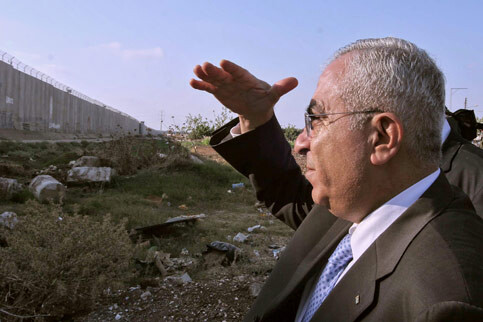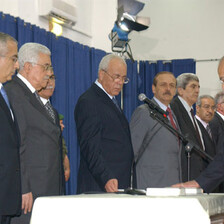The Electronic Intifada 1 September 2008

Appointed Palestinian Authority Prime Minister Salam Fayyad looks at the Israeli wall in the West Bank city of Qalqilya. (Khaleel Reash/MaanImages)
I am often struck by the stark contrast between the endless amounts of advice and wisdom proffered by the ubiquitous international actors and “experts” to help Palestinians ameliorate their condition and the lack of action, comment or consequence from these same quarters toward the naked brutality of Israel’s colonial policies. What’s even more disturbing — despite the obvious asymmetry between both parties to the conflict — is the international conflict practitioners’ mindset qualifying the actions of both sides as somehow equally wrong and right, with 50 percent right balancing and eventually canceling out 50 percent wrong, leaving us at zero, a simple equation, a matter of enlightened numeric logic.
This “balanced” analytical approach — eloquently pointed out by the late Palestinian thinker Edward Said as a harmful fallacy — seems to be part of a larger trend reshaping the conflict resolution (or is it conflict management?) professional’s toolkit and lenses in the context of the Israel-Palestine zero-sum game. The international community’s (and by extension Palestinian elite’s) logic of this trend — what I call peaceonomics — is rather straightforward: the underlying political causes are too complex and messy to deal with and our input so far has not produced an improved reality, so let’s redesign the input, re-imagine reality and re-arrange the phases of the conflict resolution process.
Substituting diplomatic tools to address and solve the main driving forces of the conflict with post-conflict tasks of institution-building and capacity development in all possible spheres of life has become increasingly fashionable, feeding and sustaining the illusion of contributing to real progress. What is worse, the Palestine question has repeatedly been reframed as a humanitarian, economic and institutional, rather than national problem. In addition, the creation of the Palestinian Authority (PA) shifted most of the internal energy away from the traditional and essential tasks of a liberation movement to the competition for “government” positions within vacuous power structures sustained almost entirely by external funding. Hence, any conceivable self-determination strategy is being ossified and substituted by all sorts of “projects” within the rapidly fragmented Palestinian cantons. Ironically, Palestinians are building their own prisons from within.
During the last 15 years Palestinian decision-makers have trapped their people in a Sisyphean dilemma: their pursuit of a circular economic and institutional development agenda at the expense of consistent traditional liberation strategies has inevitably led to a shrinking territorial base, more dependence on external aid and unprecedented internal political tension. Any hopes for Palestinian freedom have been buried under the billions of European Union and United States taxpayers’ money numbing the Palestinian elite’s courage to admit past failures and prevent any attempts to examine the failing national strategy or its implications and independently redefine it. As a result, Palestine has become a laboratory for countless conflict resolution practitioners engaging in the art of peaceonomics.
The embrace and advocacy of peaceonomics both by international and local actors is akin to the tale of the Emperor’s New Clothes. Within the context of the Israel-Palestine conflict, the bitter analogy is the lack of courage among the diplomatic and donor community, as well as their Palestinian counterparts to tell the Emperor the blatant truth. Ultimately, peaceonomics is an impressive mental tool deviating the attention and energy from the real driving forces of the conflict: Israeli territorial expansion within, and dissection of, the Palestinian territories through full and intensified control over the Palestinian population by enhancing the occupation’s architecture (e.g. the wall, light rail, separate and long-winded transportation routes, etc.) leaving little, if any meaningful contiguous territory for the Palestinians’ shrinking political ambitions.
Statements from US President George W. Bush and former and current UK Prime Ministers Tony Blair to Gordon Brown have focused on strengthening the Palestinian institutions and improving livelihoods, claiming that this will lead to “a more conducive political atmosphere for peace.” Even the appointed Palestinian Authority Prime Minister Salam Fayyad has asserted that he will build “a state under occupation.” However, as long as self-determination is subordinated under self-pacification demands, even the seemingly savvy Fayyad will be trapped in the fog of self-deception.
The Palestinian decision-making elite that comprise the PA and its supporters seem to have accepted the failure of the self-determination struggle and do not conceive of any other option but acquiescence with the current imprisoning reality. As a result, the PA has functioned more as a Pacification Authority (very much the initial purpose as defined in the Israeli-drafted Oslo accords) controlling its own people to “behave properly” despite Israeli policies narrowing any opportunity for Palestinian freedom.
Investment and economic activity in the Palestinian territories require stability due to the need for functioning relations with Israeli borders and officials. However, the “stability strategy” is designed not to upset the US and Israel and the constant call for calm is incompatible with the experience of comparative liberation struggles, which all pursued a strategy of rendering the imposed unjust situation both administratively and morally unmanageable for the colonizing or occupying party. The main methods employed were sustained civil disobedience and non-cooperation strategies bolstered by and integrated with strong and effective communication and diplomatic lobbying efforts. Both strategies require the internal support and unity of the colonized and occupied population rather than the expectation of false and cynical statements and processes couched in misleading euphemistic terms (“peace process,” “security,” “economic development,” etc.) proffered by the US, the European Union, and Israel.
While there is no “best practice” for self-determination strategies, four basic steps can be distilled from comparative historic cases:
First, retaking the right to determine one’s own cause and strategy and vehemently dismissing the Sisyphean logic of peaceonomics is a good start. No doubt, the Palestinian question is placed within the tides of geopolitical power games, which leaves very little room to navigate a fragile ship. However, no matter how bad the odds are, the key to advancing a cause is to use all possible diplomatic tools — political, economic and legal — as opposed to betting all cards on the ruthless master’s change of heart. In essence, the currency of diplomacy is leverage, not sympathy.
Second, in order to obtain leverage, media attention must be steered to the underlying causes of the conflict in a creative way rather than on the inevitable consequences of the divided political and social Palestinian house. Is it too embarrassing for the PA elite to call for a march to Jerusalem with the obvious premature dead-end at Qalandiya checkpoint, which is located deep inside Palestinian territory? Imagine the powerful news image of PA President Mahmoud Abbas pointing to the eight-meter high wall in absolute disbelief with Israeli soldiers and private security guards pointing their guns at the assembled participants. Imagine Abbas asking CNN and BBC cameras the simple question, which is on the mind of every Palestinian and semi-cognizant diplomat: “How can I build a state with this wall cutting it into little pieces? How could anyone?” Complaining in endless meetings with international representatives behind closed doors is futile. A self-determination movement demonstrates leadership and obtains negotiating leverage by effectively mobilizing and galvanizing its population to direct international attention to the main obstacles for progress. The obvious communication tool is: “do not tell, but show!” In this regard, the partial successes of consistent protests against the wall at Bil’in and Nil’in are lessons to be built upon.
Third, pretending to be “statesmen without a state” has allowed the Palestinian elite to avoid honestly assessing the harsh reality of the Palestinian condition. The theme of “building a Palestinian state” has been abused consistently as a smokescreen by the Israeli government, the international community and PA officials to destroy any possibility to actually build one. Regardless of its ultimate political expression, advancing freedom must be the guiding criteria and priority for any type of international engagement in and for Palestine. Palestinians are the only judges on what that means.
Finally, provoking a more open and inclusive policy debate within Palestine would generate a wider range of diplomatic options. A stateless and fragmented people that is left out from crucial decisions and debates about its own fate knows very well that its deliberate exclusion is due to the Palestinian elite’s fear of having to admit their past failures and engage in self-criticism. Pursuing an open culture of debate within the Palestinian body politic will both reinvigorate energy in the rapidly diminishing secular political camp and increase much-needed social and political cohesion.
Peaceonomics is amazingly effective in sustaining a high level of self-deception among both international actors and their Palestinian counterparts. It acts as a tranquilizer for the Palestinian elite and the international community beautifying and sanitizing the consequences of Israel’s occupation rather than focusing all energy on dealing with how it can be challenged and ultimately ended. If Palestinians are the highest recipients of foreign aid per capita in the world, why have unemployment and poverty rates reached unprecedented levels in the past few years? If moving within the Palestinian territories has become almost unbearable and impossible due to the high number of permanent checkpoints and a complicated ID and permit system, can livelihoods really improve behind the concrete walls built around the major Palestinian cities? How can a bi-annual prisoner release of roughly 200 out of 11,000 Palestinians in Israeli prisons “bolster the popularity of moderates” while Israel arrests the same number during one month? Who benefits from millions of US dollars for capacity-building programs for Palestinian security forces when the Israeli military repeatedly enters any Palestinian town and kills with impunity? What’s the purpose of increased administrative efficiency of the PA’s Ministry of Health when people in need of urgent medical attention die at Israeli checkpoints due to the prohibition to cross and receive treatment in Jerusalem?
I wonder how many Palestinian children it will take to tell the Emperor that he is utterly naked.
Sami Aburoza is a graduate of Harvard University and a cofounder of the Institute for Strategy and Leadership (ISL), a strategic advisory service for local and regional organizations. ISL also aims to orchestrate difficult dialogues and stimulate more debate on Palestinian diplomatic strategies.


